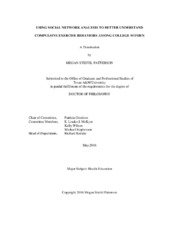| dc.description.abstract | Compulsive exercise, or the drive to exercise despite physical, social, or emotional consequences, is a common precursor and symptom of eating disorders. College-aged women are at high risk of developing disordered behaviors including compulsive exercise compared to other population subgroups. Social network analysis (SNA) is a theoretical perspective and methodology that allows researchers to observe the effect of relational dynamics on people’s behaviors and could be particularly useful in studying compulsive exercise. The purpose of this dissertation was to use SNA to investigate compulsive exercise among college women. To do so, we conducted two systematic literature reviews and two SNAs.
The first systematic review documented 38 studies investigating which factors shape disordered exercise and answered the question whether SNA has been employed in these reports. The second systematic review documented 15 studies using SNA to investigate the health of college-aged adults. This review provided insight into which health behaviors were studied among college-aged adults, and which network variables were related to their behavior. The first SNA employed a whole network design to measure network characteristics related to compulsive exercise within a sample of college women. The second SNA comprised an egocentric network analysis and measured the ego network characteristics related to compulsive exercise within the same sample.
Results from the two systematic reviews and two SNAs support the use of SNA in studying compulsive exercise among college women. Results suggest: (a) psychological influences on compulsive exercise, including personality and body dissatisfaction, are the most commonly reported factors in the literature; (b) network centrality and homophily influence drinking behavior (the most common health concern studied using SNA among college-aged adults); (c) eigenvector centrality, closeness, and clustering were the whole network variables related to compulsive exercise in the network analysis we conducted; and (d) ego network composition, specifically being close to roommates and siblings, was related to compulsive exercise behaviors in our egocentric network study. Implications for future research and practice are discussed. | en |


